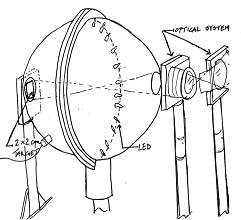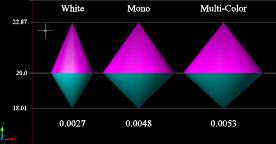|
|


Experimental apparatus providing uniform illumination from a white LED. A two-dimensional test object positioned on one side of the sphere is viewed from the opposite side through a magnifying (3.5x) lens system.
TECHNICAL PAPER: 
Color and Brightness Discrimination of White LEDs
(2002)
|
Discriminable Color and Brightness Differences in White LEDs (2002)
Phosphor-based white LEDs differ in luminance and chromaticity almost more than any other light source. How much do these differences matter? That depends on how they are perceived under certain conditions, such as whether illuminating a white scene or object, or one that contains color. A study was conducted to test subjects’ responses to these differences. The main goal of this study was to develop three-dimensional “tolerance zones” (chromaticity and luminance) from controlled subjective experiments. One experiment examined perceived differences in color for different white LEDs of the same luminance; a second experiment examined perceived differences in brightness for the same white LED operated at different luminances. The intention was to develop “tolerance zones” from the subjective data to be used as specification criteria for maintaining consistent chromaticities and luminances of white LEDs for applications where they might be used to illuminate colored and achromaticobjects.
EXPERIMENT
Subjects compared successive presentations of white LEDs, a reference LED as a control then one of ten others as a test, on each of three backgrounds: either a white card, a stamp with monotone design, or a vividly colored stamp (Figure 1). The stamps were magnified through a series of lenses to appear larger than they were. Subjects then indicated whether or not they saw a color or brightness difference when the background was lighted by each LED pair.
 |
 |
 |
| Figure 1. Three target backgrounds: a monotone stamp, a multi-colored stamp, and a pure white card. |
CONCLUSIONS
Whether a background was white or colored had more of an impact on discriminability of differences for chromaticity than for luminance. Tolerance zones were developed based upon when subjects did not notice a difference in either color or brightness approximately 58% of the time (Figure 2). It was concluded that the most stringent specification criteria for the achromatic, or white, background be adopted as an interim standard for manufacturers to use. A more relaxed standard could be used when illuminating colored backgrounds. All chromaticities and luminances falling within the 3D tolerance zones should not be noticeable to the majority of people. Since white LEDs undergo a costly binning process, this provides a tool for manufacturers to maximize the size of tolerance ranges for chromaticity and luminance in order to minimize binning costs.
 |
| Figure 2. Rendering of three-dimensional solid, representing color and brightness limits for each test object, at a reference luminance of 20 cd/m2 and a reference u’, v’ chromaticity of 0.2087, 0.4665. |
|
|
|


